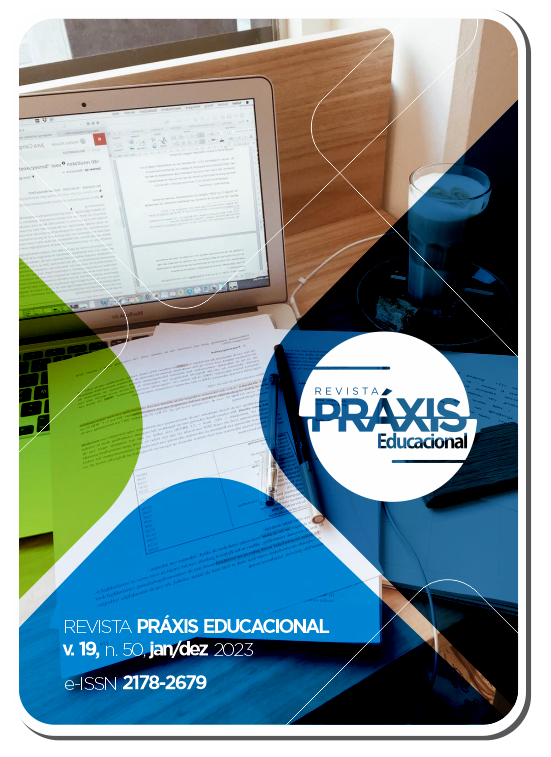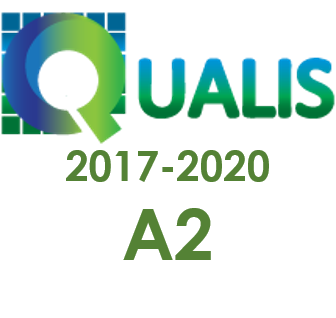Thinking Routines for training visual art teachers
DOI:
https://doi.org/10.22481/praxisedu.v19i50.12499Keywords:
art education, cultural mediation, teaching methodology, teacher training, Thinking RoutinesAbstract
The article discusses the relevance of Thinking Routines for the training of visual art teachers. Developed by researchers at Harvard University, this teaching-learning methodology aims to promote the development of thinking. A focus of investigation of the Routines has been the experience and interpretation of works of art. Based on the premise that cultural mediation (also called appreciation or reading of a work of art) is not consolidated in the Brazilian context, we defend the importance of investigating the Routines' potential to foster specific skills and knowledge in the field of visual arts. To this end, this work presents two interconnected projects. In the extension field, the Routines were used to train basic education teachers and Youth and Adult Education students. At the same time, an action-research combined with a case study was carried out, involving the application of Routines in a discipline of an undergraduate course in visual arts. The results of both projects suggest that the open-ended and interpretive nature of the questions posed by the Thinking Routines encourages a lively and dynamic conversation, developing thinking dispositions important for the understanding of art. On the other hand, the methodology did not prove adequate to deepen the understanding of theories and concepts specific to the visual arts. Based on these inferences, it is suggested to combine the Thinking Routines with other cultural mediation approaches of a cognitive nature, such as the Critical Understanding of Art, developed by Teresinha Franz, and the Critical Investigation, proposed by George Geahigan.
Downloads
Metrics
References
ARANTES, Francielle Farias. Por uma didática desenvolvimental da subjetividade no ensino de música na escola. Orientador: Roberto Valdes Puentes. 2018. 324 f. Tese (Doutorado em Educação). Universidade Federal de Uberlândia. Uberlândia, MG, 2018.
ARTFUL THINKING. [2015?]. Disponível em: http://pzartfulthinking.org/?page_id=5 Acesso em 21 abr. 2023.
BARBOSA, Ana Mae. Leitura da imagem e contextualização na arte/educação no Brasil. Revista GEARTE, Porto Alegre, v. 9, p. 1-17, 2022. Disponível em: https://seer.ufrgs.br/index.php/gearte/article/view/127855 Acesso em: 6 abr. 2023.
BARBOSA, Ana Mae. Uma introdução à arte/educação contemporânea. In: BARBOSA, Ana Mae. (org.). Arte/Educação contemporânea: consonâncias internacionais. 3ª ed. São Paulo: Cortez, 2010, p. 11-22
BRASIL. Orientações Curriculares para o Ensino Médio, v. 1, Linguagens, códigos e suas tecnologias. Brasília: Ministério da Educação, Secretaria de Educação Básica, 2006.
CHIN, Christina. Comparing, contrasting and synergizing Visual Thinking Strategies (VTS) and Aesthetic Education strategies in practice. International Journal of Education Through Art, v.13, n.1, p. 61-75, 2017.
DEWEY, John. Arte como experiência. São Paulo: Martins Fontes, 2010.
EDX. Teaching critical thinking through art with the National Gallery of Art. [2020?] Disponível em: https://www.edx.org/course/teaching-critical-thinking-through-art-with-the-na Acesso em: 21 abr. 2023.
EFLAND, Arthur. Cultura, sociedade, arte e educação em um mundo pós-moderno. In: A COMPREENSÃO E O PRAZER DA ARTE, 1998, São Paulo. Tradução: Ana Amália Barbosa e Jorge Padilha. Anais eletrônicos [...] São Paulo: SESC/SP, 1998.
FRANZ, Teresinha Sueli. Educação para uma compreensão crítica da arte. Florianópolis: Letras Contemporâneas, 2003.
FRANZ, Teresinha Sueli. Os estudantes e a compreensão crítica da arte. Imaginar. Porto: APECV n. 49, p. 4 – 11, jan. 2008. Disponível em: http://apecv.pt/revista/imaginar49web.pdf Acesso em: 08 abr. 2023.
GEAHIGAN, George. Art criticism: From theory to practice. In: WOLFF, Theodore; GEAHIGAN, George. Art Criticism and Education. Urbana and Chicago: University of Illinois Press, 1997, p. 123 – 278.
HAANSTRA, Talita G. F.; KÁRPÁTI, Andrea. A new tool for developmental assessment based on the Common European Framework of Reference for Visual Literacy: an international usability study. International Journal of Education Through Art, v. 14, n. 3, p. 353–78, 2018.
HARVARD. GRADUATE SCHOOL OF EDUCATION. Project Zero. [2015?]. Disponível em: https://pz.harvard.edu/who-we-are/about Acesso em 21 abr, 2023.
HUGHES, Arthur. Don’t judge pianists by their hair. Journal of Art & Design Education. v.12, n.3, p. 279-289, 1993.
KIM, Kyoung Jin; WEE, Su-Jeong; HAN, Mink-Kyung; SOHN, Ji-Hyang; and HITCHENS, Carolyn Walker. Enhancing children’s art appreciation and critical thinking through a visual literacy-based art intervention programm. International Journal of Education Through Art, v. 13 n. 3, p. 317–32, 2017.
MORAN, José. Metodologias ativas para uma aprendizagem mais profunda. In: BACICH, Lilian.; MORAN, José. (org.) Metodologias ativas para uma educação inovadora. Porto Alegre: Penso, 2018, p. 1-25.
OSTROWER, Fayga. Universos da Arte. Rio de Janeiro: Campos, 1983.
PARSONS, Michael. Mudando direções na arte-educação contemporânea. In: A COMPREENSÃO E O PRAZER DA ARTE, 1998, São Paulo. Anais eletrônicos... São Paulo: SESC/SP, 1998.
PREFEITURA DE BELO HORIZONTE. Circuito de Museus. 23 fev. 2018. Disponível em: https://prefeitura.pbh.gov.br/educacao/circuito-de-museus Acesso em: 20 abr. 2023.
RODRIGUES, Rômulo Soares. Rotinas de Pensamento na Educação de Jovens e Adultos. 2023. Trabalho de Conclusão de Curso (Artes Plásticas – Licenciatura) Escola Guignard, Universidade do Estado de Minas Gerais. Belo Horizonte, 2023.
RONAN, Gabriel. Redes sociais repercutem fumaça no céu de BH; bombeiros culpam volume de incêndios. Estado de Minas, Belo Horizonte, 18 set. 2019. Disponível em: https://www.em.com.br/app/noticia/gerais/2019/09/18/interna_gerais,1086291/redes-sociais-repercutem-fumaca-em-bh-bombeiros-culpam-incendios.shtml Acesso em: 08 abr. 2023.
SCHÖNAU, Diederik.; KÁRPÁTI, Andrea. Renaming the framework: Common European Framework of Reference for Visual Competency. International Journal of Education Through Art, v. 15, n. 1, p. 95–100, 2019.
TATE. Sublime: art terms. [2017?] Disponível em: https://www.tate.org.uk/art/art-terms/s/sublime Acesso em: 08 abr. 2023.
TISHMAN, Shari; PALMER, Patricia. Works of art are good things to think about. In: EVALUATING THE IMPACT OF ARTS AND CULTURAL EDUCATION, 2007, Paris. Conference Procedings […] Paris: Centre Pompidou, 2007, p. 89-101. Disponível em: https://pz.harvard.edu/sites/default/files/WorksOfArt.pdf Acesso em: 08 abr. 2023.
TRIPP, David. Pesquisa-ação: uma introdução metodológica. Educação e Pesquisa, São Paulo, v.31, n.3, p.443-466, set./dez.2005. Disponível em: http://www.scielo.br/pdf/ep/v31n3/a09v31n3.pdf Acesso em: 26 nov. 2021.
VARGAS, Vagner de Souza. Dramartugia da corporeidade: a pedagogia do evento teatral. 2018. 231 f. Orientadora: Denise Marcos Bussoletti. Tese. (Doutorado em Educação). Universidade Federal de Pelotas. Pelotas, RS, 2018.
VIANNA, Rachel de Sousa; SANTOS, Andrea Adelina Vieira. Diretrizes da educação museal em museus de arte e centros culturais da Região Metropolitana de Belo Horizonte. ENCONTRO NACIONAL DA ANPAP, 23., 2014, Belo Horizonte. Anais eletrônicos [...] Belo Horizonte: ANPAP, 2014, p. 744-758.
VIANNA, Rachel de Sousa; REZENDE, Raquel Jacqueline Emerenciana. Mediação em artes visuais no contexto escolar: um estudo de caso e uma proposta de formação de professores. Educação em foco, ano 19, n. 29, p. 61-82, set./dez. 2016.
VIANNA, Rachel de Sousa, LIZARDO, Lucimar Aparecida Rocha. Um estudo sobre mediação em artes visuais na educação básica. In: CONGRESSO DA FEDERAÇÃO DE ARTE-EDUCADORES DO BRASIL, XXXI, 2022, Juiz de Fora. Anais eletrônicos [...] Juiz de Fora, MG: UFJF, 2022, p. 1-12. Disponível em: https://even3.blob.core.windows.net/anais/513150.pdf . Acesso em: 08 nov. 2023.
VTS. [2017?]. Disponível em: https://vtshome.org/about/ Acesso em: 21 abr. 2023.
Downloads
Published
How to Cite
Issue
Section
License
Copyright (c) 2023 Práxis Educacional

This work is licensed under a Creative Commons Attribution-ShareAlike 4.0 International License.
You are free to:
Share - copy and redistribute the material in any medium or format; Adapt - remix, transform, and build from the material for any purpose, even commercially. This license is acceptable for Free Cultural Works. The licensor cannot revoke these freedoms as long as you follow the terms of the license.
Under the following terms:
Attribution - You must appropriately give credit, provide a link to the license, and indicate if any changes have been made. You may do so in any reasonable way, but not in a way that suggests that you or your use is endorsed by the licensor.
There are no additional restrictions - You cannot apply legal terms or technological measures that legally restrict others to make any use permitted by the license.










